Yeti SB135
Wheel Size: 27.5’’’
Travel: 135 mm rear / 150 or 160 mm front
Geometry highlights:
- Sizes offered: XS, S, M, L, XL
- Headtube angle: 65° / 65.4°
- Seat tube angle: 76.5° / 77°
- Reach: 460 mm (size Medium)
- Chainstay length: 429 mm to 437 mm (2 mm increments per size)
Frame Material: Carbon Fiber
Price:
- Frame w/ Fox Float Factory shock: $4,300
- Complete bikes: $6,400 to $10,300
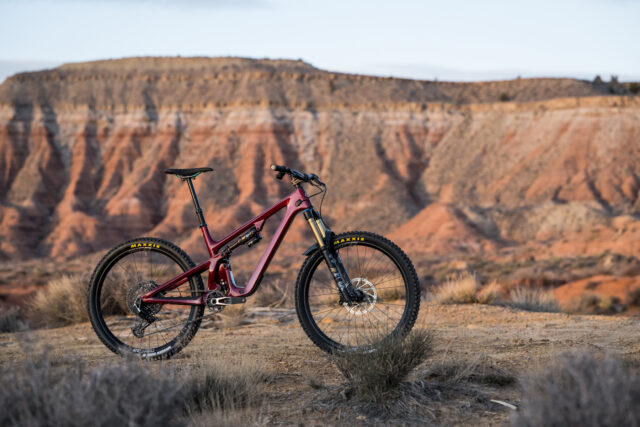
Intro
Late last year, Yeti overhauled its line of 29ers, unveiling the new SB160, SB140, and SB120. That left them in the slightly confusing position of having two bikes called the SB140 in their lineup — the 27.5’’ wheeled version from a few years ago, and the new 29’’ one (which is a replacement for the SB130 that sat alongside the older SB140 in the Yeti line).
Today that all gets straightened out, as the older 27.5’’ wheeled SB140 gets replaced with the new SB135 — which, despite the current trendiness of mixed-wheel-size configurations, keeps rolling on dual 27.5’’ wheels. And while the SB135 and new 29’’ SB140 have similar travel numbers (and some significant similarities in geometry that we’ll cover in more detail below), Yeti talks about the two quite differently, describing the SB140 as the more speed-oriented, game-on bike of the two, and the SB135 as the more nimble, playful alternative.
So what has Yeti done to differentiate the two beyond just wheel size, and what makes the SB135 stand out? Let’s dive in.
The Frame
In terms of overall design and layout, the SB135 bears a strong family resemblance to the SB120, SB140, and SB160 that Yeti launched last year. The Switch Infinity suspension and overall lines of the frame carry over to the SB135. So do the host of updated features that Yeti rolled out on the new 29ers, including switching back to a threaded bottom bracket shell, and a host of refinements to the linkages, pivot hardware, cable routing, and frame protection. All of the pivot bearings are now pressed into the aluminum linkage parts, which Yeti says makes service easier, saves weight (since there’s less material required in the carbon fiber front and rear triangles to accommodate bearing seats), and means that you’re only likely to damage a smaller, far less expensive linkage part in the event of a botched bearing swap.
The cable routing is still fully internal, but it’s fully guided through both the front and rear triangles, and Yeti’s redesigned their cable ports to lightly clamp the cables at most of the exit points, as well as at the main pivot to help keep things in place and rattle-free. Various versions of those cable ports and guide pieces are included with the SB135 to swap in if you’re running wireless controls and don’t need as many provisions for cable routing (or vice versa, if you swap a cable-actuated drivetrain onto a build that comes with a wireless one) to keep things looking tidy.
The SB135 also gets the revised ribbed chainstay protector and beefed-up downtube guard from the other new bikes in the Yeti line, and the bolt-on downtube guard can be removed, exposing an opening in the bottom of the frame to help sort out routing for the dropper cable. And the SB135 features a SRAM UDH derailleur hanger for compatibility with the new SRAM Transmission, which is offered on some SB135 builds — more on those in a minute.
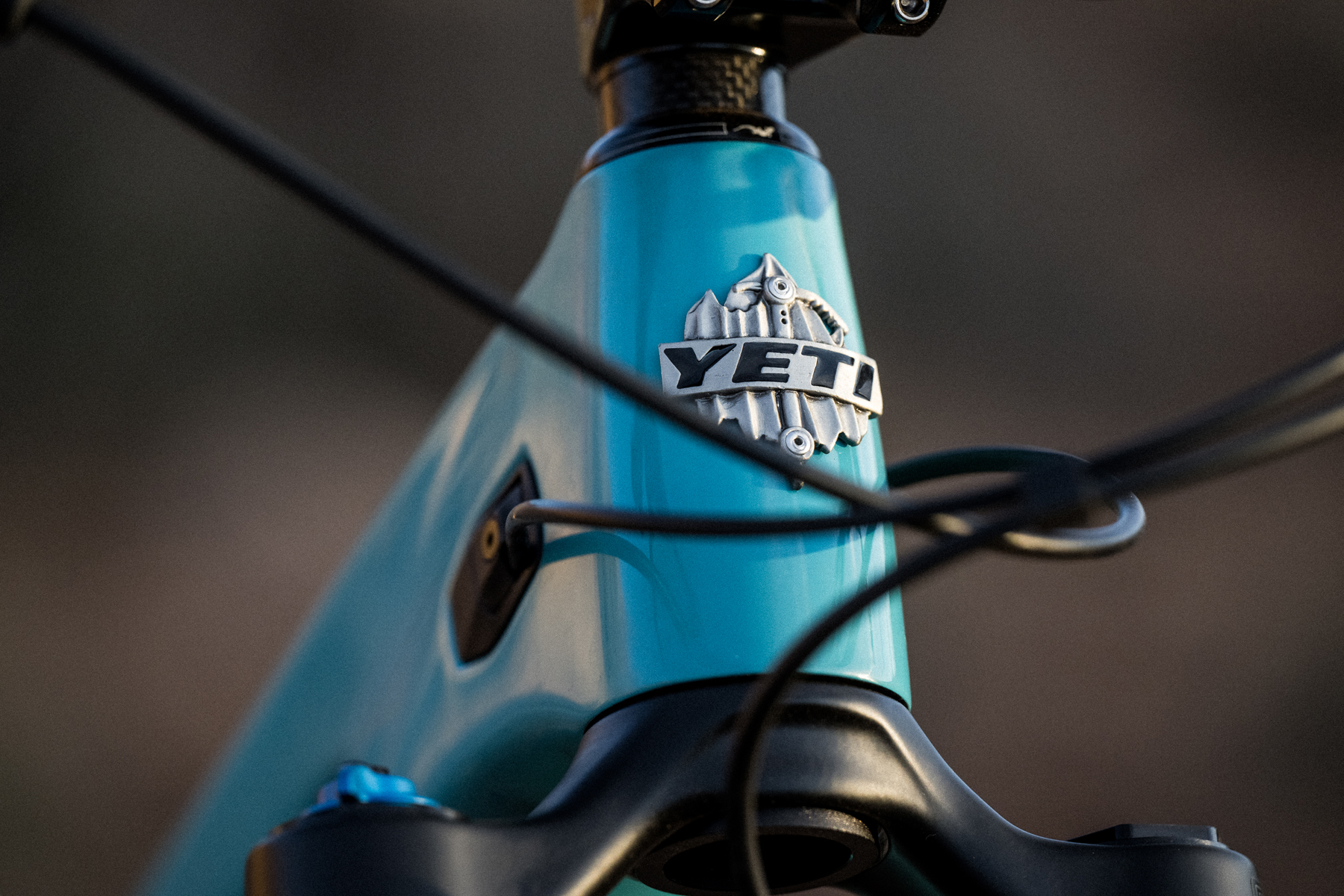
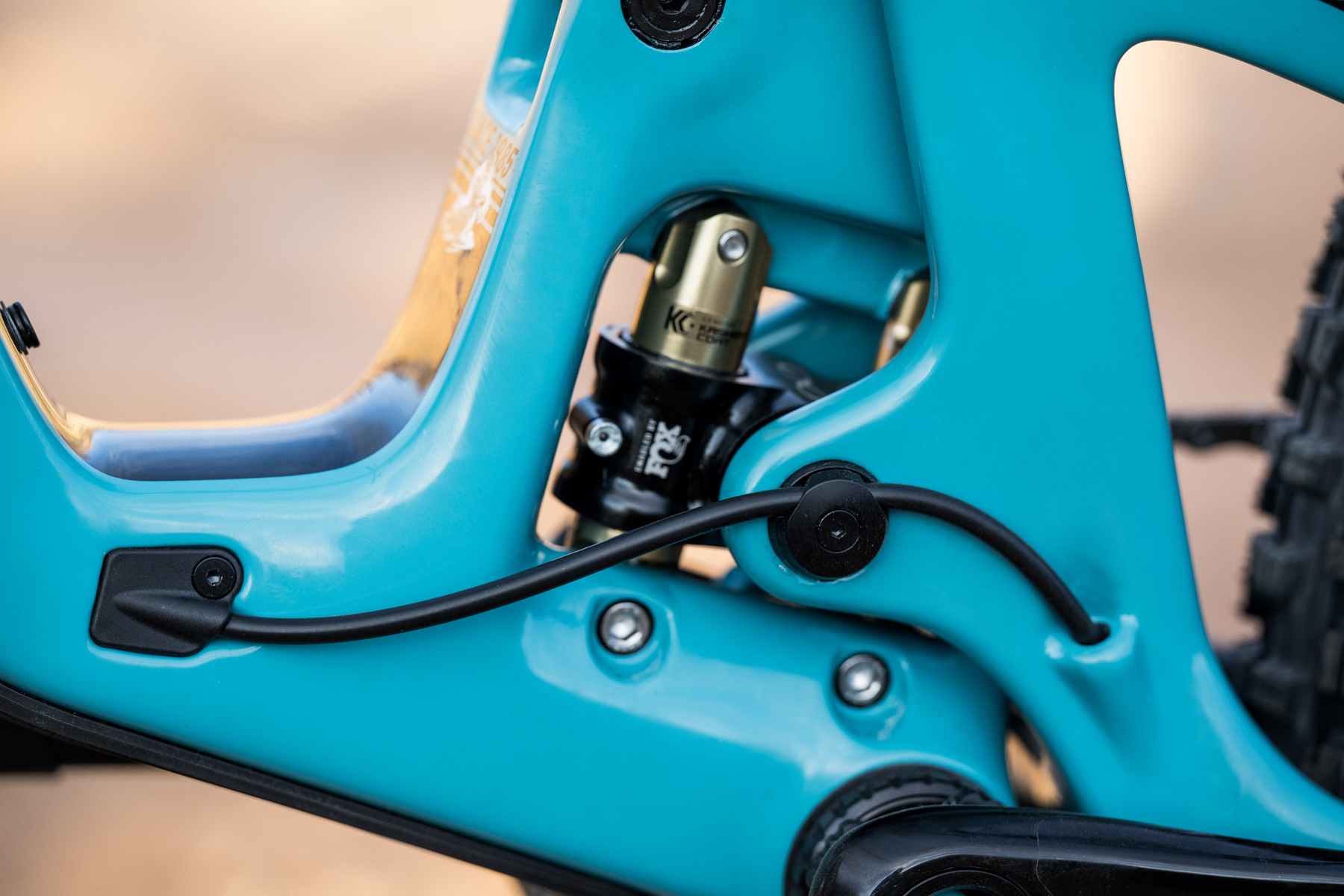
But where things get a bit unusual with the SB135 is in the frame layout for different sizes. Yeti has adopted size-specific chainstays (accomplished by moving the suspension pivots on the front triangle, rather than size-specific swingarms). That is common enough these days, but Yeti has also taken the uncommon (and quite cool) extra step of completely redesigning the frame layout for the Small and XS sizes to position the shock lower in the frame. That lets Yeti squeeze substantially more standover clearance on the smaller frames than would be possible with the layout on the larger sizes, while maintaining overall similar aesthetics and not requiring a big top tube hump as we’ve seen on some of their older XS bikes, dating back to the SB5.
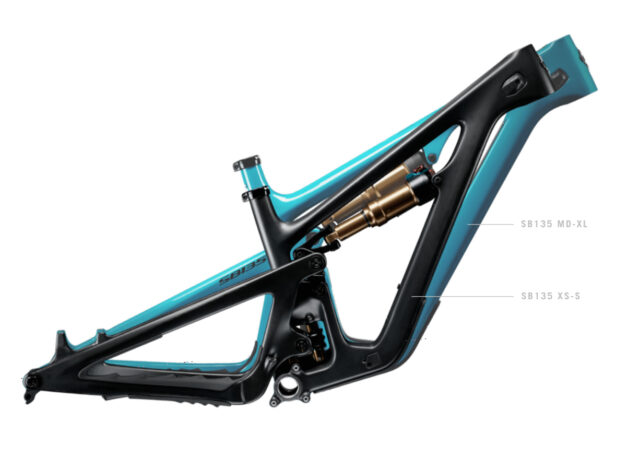
All of that does mean that the Small and XS frames get their own rear triangle and linkage parts that are different from those used on the bigger sizes, and while that does necessitate very fractionally different suspension kinematics between the two variants, Yeti says that they’re extremely similar. The tweaked frame layout does mean that the Small and XS frames don’t have room for a piggyback rear shock (which the larger sizes can accommodate) but all get space for a water bottle inside the front triangle.
The leverage curve on the SB135 is mostly linear (and overall pretty low leverage) going from about 2.6:1 to 2.25:1, with a slight steepening of the curve toward additional progression very late in the travel. Other kinematic graphs aren’t published.
Mixed-wheel configurations are definitely trendy these days, but Yeti’s case for not going with one on the SB135 is that their goal was to make a bike that’s especially quick-handling and nimble, and that smaller wheels are still the best way to do that. And though they’re not listing a geometry chart for such a setup or offering it directly, Yeti does acknowledge that some folks are likely to put a 29’’ front wheel on the SB135 anyway. That said, a 140mm-travel 29er fork and wheel package is still substantially taller than even the 160mm-travel 27.5’’ fork and wheel spec’d on the LR builds, and Yeti doesn’t recommend a mullet setup.
Fit & Geometry
Yeti offers the SB135 in sizes XS through XL, with a 65.4° headtube angle and 77° effective seat tube angle across the board. The actual seat tube angle gets fractionally steeper with each successively larger size, to compensate for the greater seatpost extension that’s expected from taller folks on bigger bikes — a clearly sensible idea that’s been slow to catch on with many brands. Reach ranges from 400 to 504 mm, with the Medium frame coming in at 460 mm and the Large at 479 mm. Chainstay lengths are also size-specific, with the XS starting at 429 mm and growing by 2 mm per size up to 437 mm on the XL.
Most of those numbers aren’t too wildly different from the new SB140 (the 29’’ one), with the SB135 getting slightly shorter reach numbers in a given size and substantially shorter chainstays, as well as having the size range shifted down a size to XS through XL instead of Small through XXL.
It’s great that Yeti is offering a truly small XS — which they say covers folks down to about 4’11’’ (150 cm) — and as we’ve talked about a whole bunch on here, the reduced stack height that you can achieve with a 27.5’’ front wheel as compared to a 29’’ one makes a lot of sense for shorter riders on smaller sized bikes. But the stack height on the SB135 does start to look notably short on the bigger sizes — by 15 mm as compared to the SB140 in the Large and XL frames, for example.
All of those stated numbers are for the standard builds with a 150mm-travel fork. The Lunch Ride builds slacken things out by 0.4° by way of a 160mm-travel fork, and in doing so lop a few millimeters off the reach and raise the bottom bracket a touch. As compared to the older SB140 (the 27.5’’ one) that the SB135 replaces, the SB135’s reach has actually gotten a touch shorter, the seat tube very fractionally slacker, and the headtube angle has remained identical. The SB135 gets size-specific chainstays whereas the SB140 had the same length across the size range (which, at 433 mm, are the same length as the Medium SB135).
The Builds
Yeti offers the SB135 in a large assortment of builds, including options for “Lunch Ride” (aka, LR) specs, as featured on the SB140, and a number of other Yeti models over the years. The LR builds bump the fork travel up to 160 mm from 150 mm, swap in a Fox Float X shock in place of a Float, substitute a Grip2 fork damper (on the TLR T3 build), get bigger brakes and rotors, and heavier-duty wheels. The inclusion of the piggyback Float X rear shock does mean that the LR builds are only available on sizes Medium and up since the Small and XS frames can only accommodate an inline shock.
And as per usual for Yeti, “C” builds get the more basic carbon layup in the frame, while “T-series” builds get the lighter, fancier Turq one. And as with the SB140, C-series builds can be upgraded to Fox Factory suspension for an upcharge, and T-series ones have an optional upgrade to DT Swiss EXC 1501 carbon wheels. Those upgrades cost $600 and $1,000, respectively.
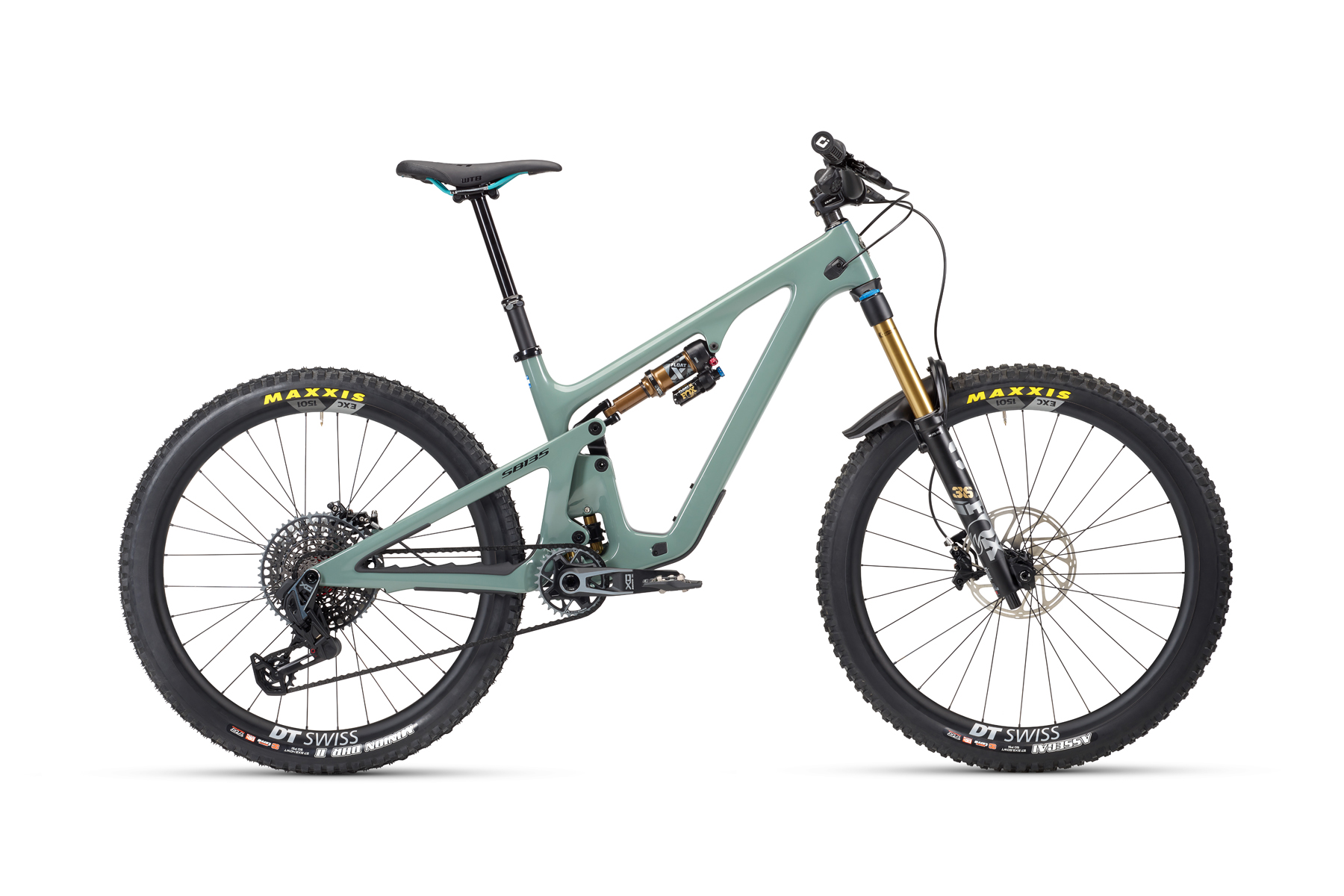
- Drivetrain: Shimano SLX
- Brakes: Shimano SLX 4-piston w/ 180 mm rotors
- Fork: Fox 36 Performance (150 mm travel)
- Shock: Fox Float Performance
- Wheels: DT Swiss M1900
- Dropper Post: OneUp (XS–S: 150 mm; M: 180 mm; L–XL: 210 mm)
- Drivetrain: SRAM GX
- Brakes: SRAM G2 R w/ 180 mm rotors
- Fork: Fox 36 Performance (150 mm travel)
- Shock: Fox Float Performance
- Wheels: DT Swiss M1900
- Dropper Post: OneUp (XS–S: 150 mm; M: 180 mm; L–XL: 210 mm)
- Drivetrain: SRAM GX
- Brakes: SRAM Code R w/ 200 mm rotors
- Fork: Fox 36 Performance (160 mm travel)
- Shock: Fox Float X Performance
- Wheels: DT Swiss E1900
- Dropper Post: OneUp (XS–S: 150 mm; M: 180 mm; L–XL: 210 mm)
- Drivetrain: Shimano XT
- Brakes: Shimano XT 4-piston w/ 180 mm rotors
- Fork: Fox 36 Factory Fit4 (150 mm travel)
- Shock: Fox Float Factory
- Wheels: DT Swiss XM1700
- Dropper Post: Fox Transfer (XS–S: 150 mm; M: 175 mm; L–XL: 210 mm)
- Drivetrain: SRAM X01
- Brakes: SRAM G2 RSC w/ 180 mm rotors
- Fork: Fox 36 Factory Fit4 (150 mm travel)
- Shock: Fox Float Factory
- Wheels: DT Swiss XM1700
- Dropper Post: Fox Transfer (XS–S: 150 mm; M: 175 mm; L–XL: 210 mm)
- Drivetrain: SRAM X0 Eagle T-Type
- Brakes: SRAM Code RSC w/ 200 mm rotors
- Fork: Fox 36 Factory Grip2 (160 mm travel)
- Shock: Fox Float X Factory
- Wheels: DT Swiss EX1700
- Dropper Post: Fox Transfer Factory (M: 175 mm; L–XL: 200 mm)
- Drivetrain: SRAM XX T-Type
- Brakes: SRAM G2 Ultimate w/ 180 mm rotors
- Fork: Fox 36 Factory Fit4 (150 mm travel)
- Shock: Fox Float Factory
- Wheels: DT Swiss XM1700
- Dropper Post: Fox Transfer Factory (XS–S: 150 mm; M: 175 mm; L–XL: 210 mm)
Some Questions / Things We’re Curious About
(1) On paper, the SB135 looks extremely similar to the older 27.5’’-wheeled SB140 that it replaces. But do they actually ride similarly, or are there significant differences lurking beneath the surface?
(2) What sorts of riders are going to get along best with the SB135, as opposed to the SB140 (or any number of 29’’-wheeled bikes in this mid-travel Trail bike class)?
(3) And how does the SB135 compare to the Pivot Shadowcat, one of the other prominent high-end 27.5’’-wheeled bikes in this travel range?
Bottom Line (For Now)
There aren’t a ton of 27.5’’ Trail bikes out there these days (especially not high-end ones), but as we’ve been arguing for a long time now, 27.5’’ wheels very much still have their place for certain riders. Yeti clearly agrees, and the SB135 looks like a really good option for folks who want a nimble, quick-handling Trail bike that’s still able to keep up on some steeper, burlier trails. We’ve got an SB 135 TLR T3 in for review, so stay tuned for a full review to come. And Blister Members can check out our Flash Review of the SB135 now.
Flash Review
Blister Members can read our Flash Review of the Yeti SB135 for our initial on-trail impressions. Become a Blister Member now to check out this and all of our Flash Reviews, plus get exclusive deals and discounts on gear, and personalized gear recommendations from us.
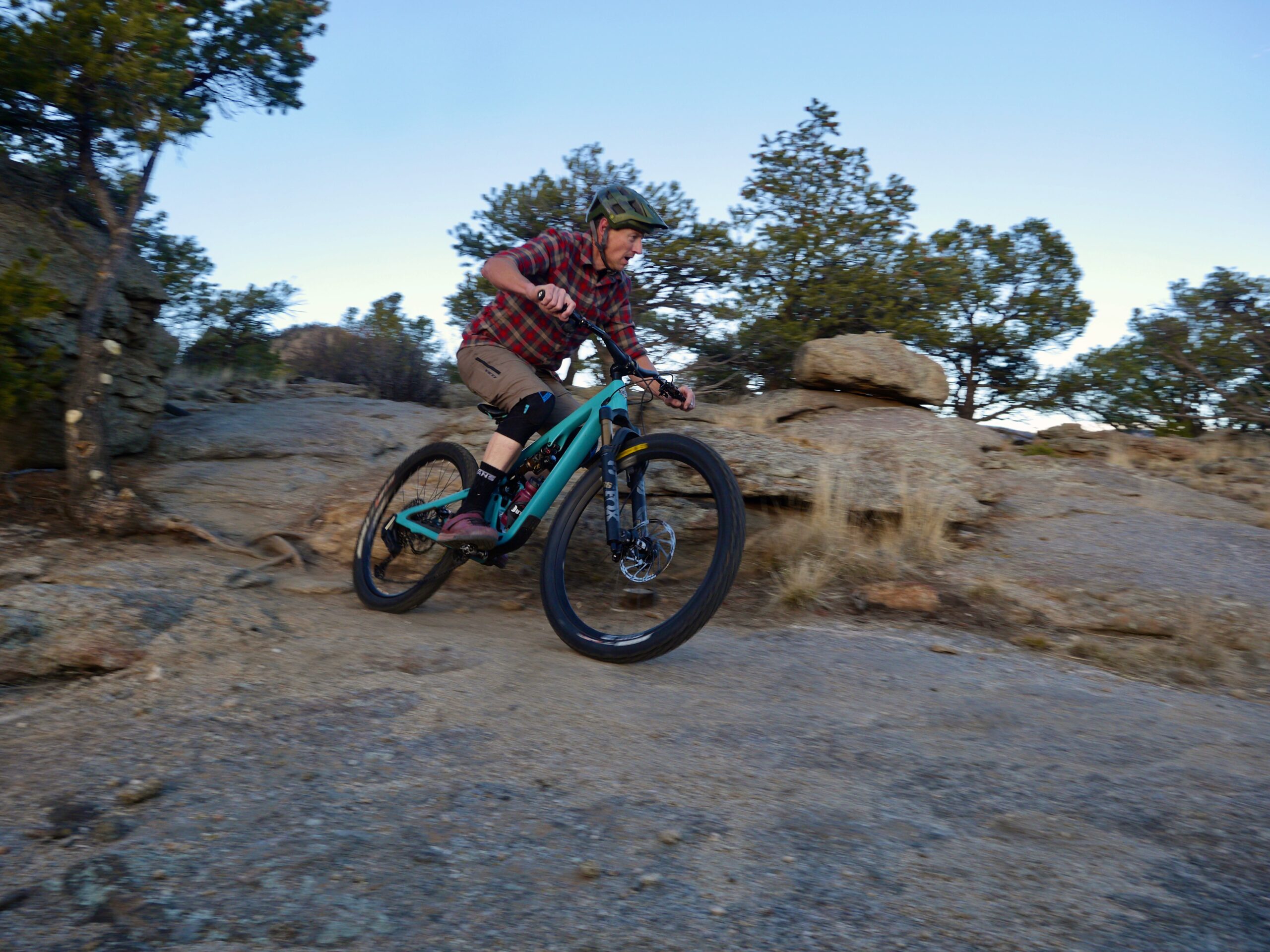
FULL REVIEW
Simon Stewart: My previous-generation SB140 is one of my all-time favorite bikes, so I was really eager to try the new SB135, which is the replacement for that SB140. And, yes, it is confusing that the SB140 used to be their 27.5’’ offering, the latest SB140 is a 29er that replaced the SB130, and now the SB135 is their current 27.5” Trail bike.
Regardless, I have amassed a ton of miles on the old SB140 and often use it as a benchmark for comparing mid-travel Trail bikes. Now, I knew when I built my SB140 that I wanted to set it up as a mixed-wheel size bike, and I actually never rode it in the full 27.5’’ configuration. I did, however, often wonder how it would’ve ridden as a 27.5” bike, so when the SB135 arrived, I was genuinely excited to get on it.
The new SB135’s geometry numbers are remarkably similar to the outgoing SB140’s, and like the old SB140, the new SB135 is a dedicated 27.5” bike — with that size wheel at both ends, not just the rear. You have to dig deep into Yeti’s FAQ section on the SB135 to find any mention of a mullet setup, where they state that, while it’s okay to set it up as a mullet, it will change the geometry significantly. Some will like the change and others will not.
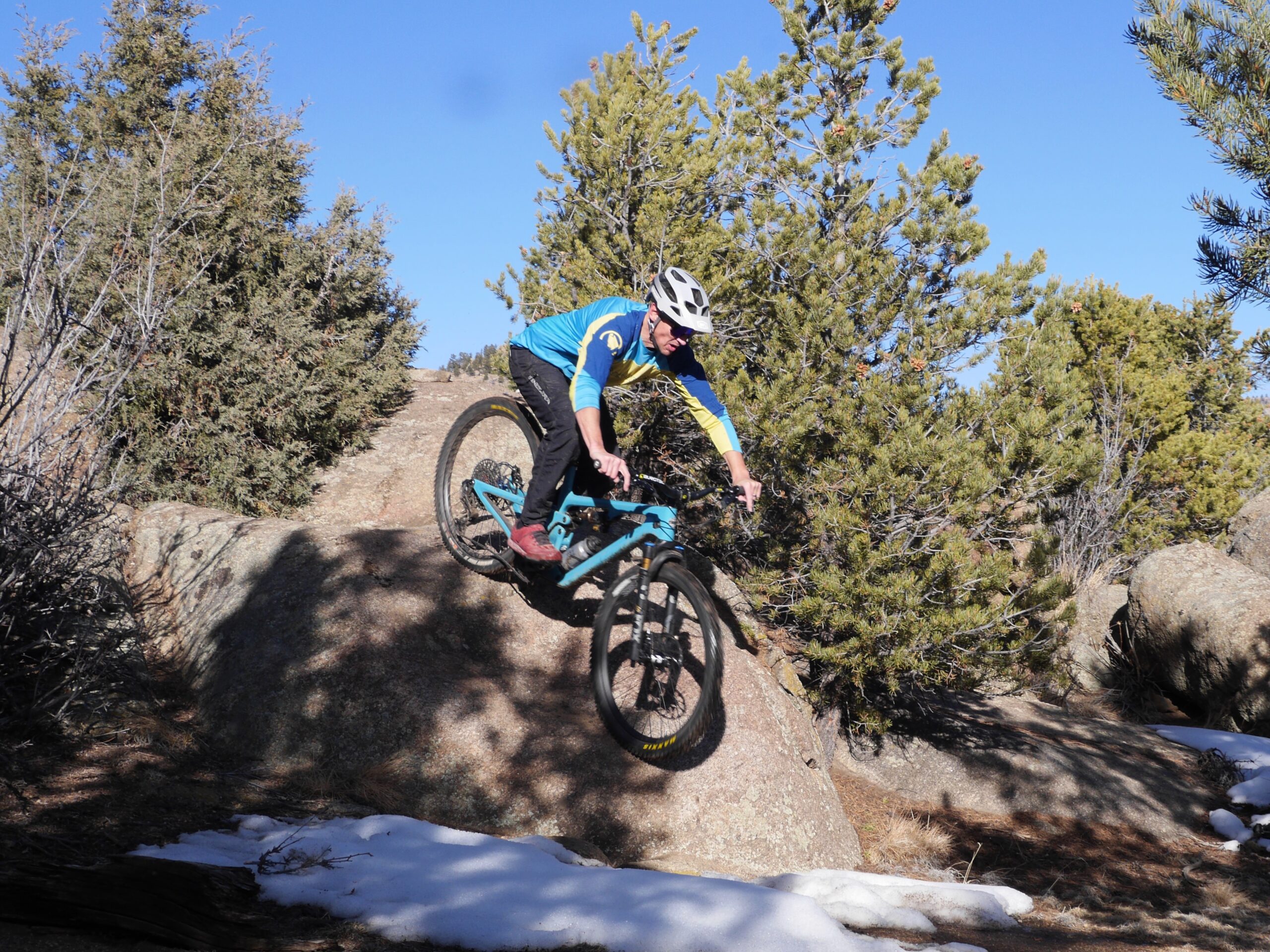
Given the popularity of mixed-wheel size bikes, we think there are a lot of riders who may be interested in the SB135 as a mullet, which is why we decided to test it in both configurations. For the mullet swap, we used a 140mm-travel Fox 36 Factory 29” fork in place of the 160mm-travel Fox Factory 36 27.5” fork. We didn’t have a 29” version of the DT-Swiss EX1700 front wheel so we used a Hope Fortus Pro 5 wheel instead, but we did use the equivalent Maxxis DHF front tire. More on that experiment later.
I think it goes without saying that, between essentially testing two bikes in this review, coupled with the fact that a dedicated 27.5” bike has a certain air of discord surrounding it, there’s a fair bit to unpack, so let’s get into it.
Fit & Sizing
Simon (6’, 170 lb / 183 cm, 77.1 kg): I rarely consider sizing down to a Medium or up to an XL on modern mountain bikes, and the Yeti SB135 in a size Large is no exception. When comparing the geometry charts of the SB135 to my prior-generation SB140, I had a good idea of how it was going to fit before it arrived, given how similar the two are on paper. I knew the 475 mm of reach (Lunch Ride version) with the spec’d 50 mm stem would probably be spot on, but I also knew the low(ish) stack height would require a handlebar swap, so I had my go-to Burgtec 50mm-rise bars on hand ready to go.
I did ride the SB135 with the stock bars when it first arrived, just to confirm the stack height was too low for my tastes, and was unsurprised to find that it was. Once I swapped the bars, the fit felt instantly familiar and comfortable. Typically I favor 40 mm stems, but the reach on the SB135 is not overly long (it’s actually 5 mm shorter than my SB140), and with its 76.5º effective seat tube angle, the SB135 has a more compact feeling cockpit. Between that and my long arms, I opted to leave the stock 50 mm stem in place. I appreciated Yeti spec’ing a 200 mm dropper post on the Large and the only part that I needed to change to dial in the fit was the handlebar.
I think, overall, the SB135 is an easy bike to fit, with no real surprises — the fit mostly feels pretty typical for a modern Trail bike. Shorter riders will appreciate the low stack height while some taller riders will most likely be shopping for a new handlebar.
David Golay (6’, 170 lb / 183 cm, 77.1 kg): I only ever rode the SB135 in the stock 27.5’’ configuration, but I’m generally on the same page as Simon about that setup. The stack height on our Large bike felt very short for my taste, but once I swapped in a 40mm-rise bar and a stem with a little rise of its own, I quite liked the fit of the SB135. It definitely felt more compact than a lot of the big Enduro bikes I’ve been spending time on — including Yeti’s own size-Large SB160 — but that’s entirely appropriate, given the SB135’s role as a more playful, shorter-travel Trail bike.
I understand wanting to keep the stack short on the smaller sizes (and think it’s awesome that Yeti has put so much effort into making the SB135 fit short folks so well), but that ceases to be relevant on the bigger sizes. I’d rather see a taller headtube on the Large frame that we rode to provide (what I think) would be a more useable range of bar-height adjustment for most folks who should be on a frame that big in the first place.
That said, I was able to get comfy by swapping on a not-that-outrageously tall bar, so it’s not like Yeti is miles off here. And while they’re not offering any stock builds with a mixed-wheel setup, I don’t doubt that some folks will want to put a 29’’ fork and front wheel on the SB135, so keeping the stack height from getting too outrageously tall for that use case does make some sense.
On that note:
SB135 Mullet Geometry
Simon: I took measurements before and after converting the SB135 to a mullet, with the caveat we noted above: when converting it to a mullet, we swapped the SB135 Lunch Ride’s 160mm-travel Fox 36 Factory 27.5” fork for a 140mm-travel Fox 36 Factory 29” fork, with the goal of minimizing drastic geometry differences.
After doing so, the bottom bracket height and the stack height ended up being much closer than I thought they would be between the two. But, as to be expected, the mullet setup still did raise the stack height, which I mitigated by lowering the stem by 2.5 mm. The mullet conversion also raised the bottom bracket, which ended up being somewhat of a plus in certain situations — more on that below.
If considering a mixed-wheel size conversion on a size XS or Small, the increased stack height is something to be aware of, and will most likely be more noticeable than it would be on the larger sizes.
Climbing
Simon: I love how my SB140 climbs, and I love how the SB130 and SB150 climb, so it comes as no surprise that the SB135 does well in this department, too.
Like the other Yetis I’ve been on recently, the SB135 excels at long mountain climbs into the thin air. However, there is a small caveat: the slight slackening of the effective seat tube angle (76.5º on the SB135 vs. 77º on the SB140 27.5’’) affected the climbing more than I expected. To be clear, it is still excellent, but on steeper climbs, the new bike’s slightly less steep seat tube angle requires a more pronounced shift forward on the saddle to stay in a good climbing position.
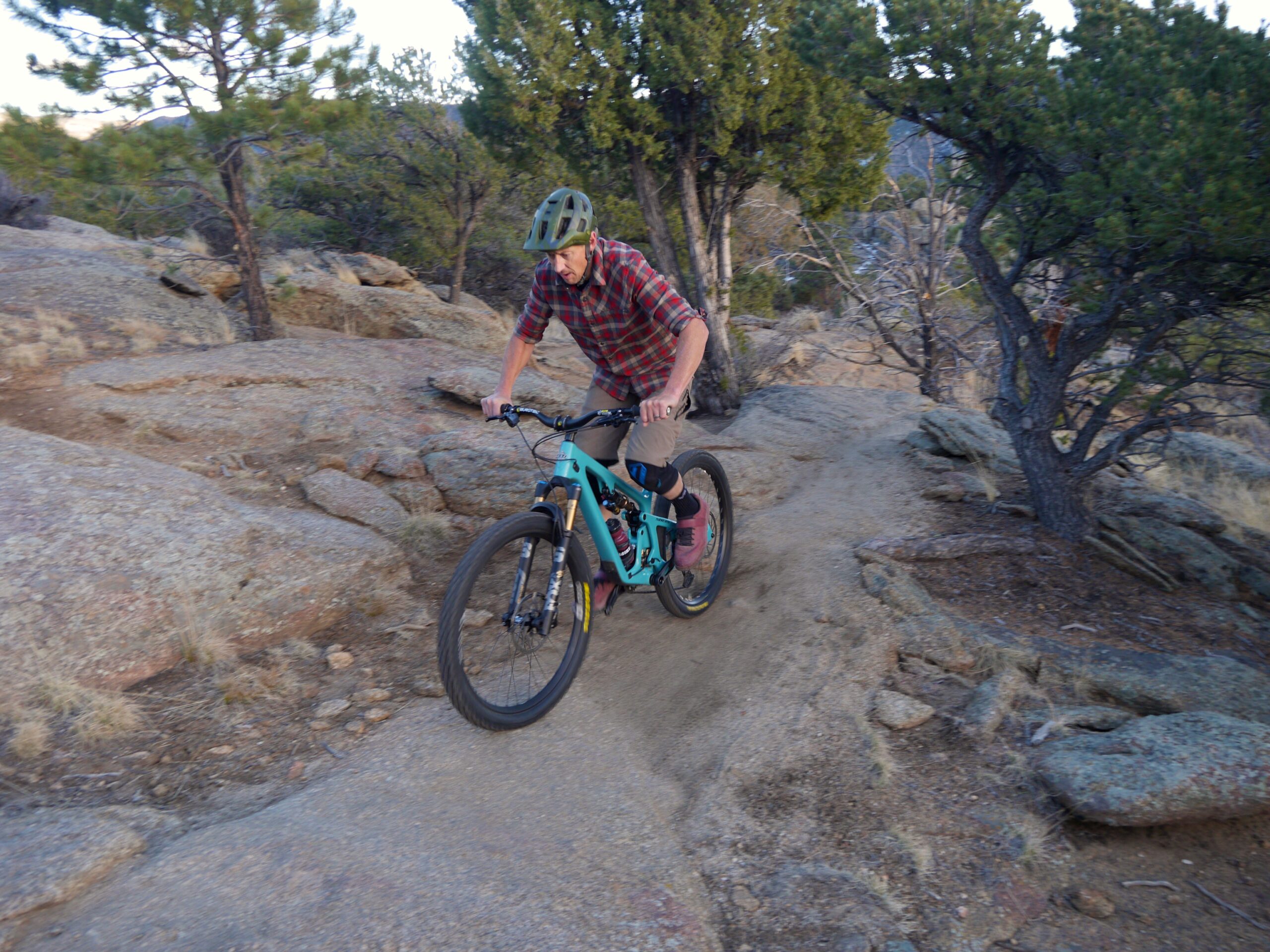
The SB135’s Switch Infinity suspension layout does a great job of maintaining traction, while also feeling supportive and efficient. I rarely use the climb switch on this bike’s Fox Float X shock since it doesn’t make much of a difference from an efficiency standpoint, but compromises traction on technical climbs a bit. Also, I had forgotten how well 27.5’’ wheels accelerate back up to speed after getting bogged down on technical moves.
Yeti states that the SB135 has the lowest bottom bracket of all their full-suspension bikes and that it was designed as such to make it rail corners, which it most definitely does. That comes at the cost of crank and pedal clearance, though. Climbing rocky, ledgy terrain on the SB135 requires that you constantly keep its low bottom bracket height in mind, and avoiding pedal strikes is pretty much impossible. This is not a deal breaker, and there are plenty of current bikes that require the same technique, but it is something to consider if your local terrain is rocky and you value clearance.
The SB135 is a bike I have no problem sitting on for hours of relentless alpine climbing. In some ways, its smaller 27.5’’ wheels proved to be advantageous, especially in tight, rocky sections. Also, I thought I would miss having 29” wheels on double-track and fire roads, but that just wasn’t the case.
David: I live in a part of the world with fewer ultra-rocky, ledge-y climbs than Simon and didn’t find myself wanting for pedal clearance on the SB135, but I’m generally in agreement with his take. By and large, the SB135’s climbing performance feels pretty neutral for a mid-travel Trail bike, combining solid efficiency with pretty good traction under power, and a pedaling position that feels pleasantly upright without being awkward during seated pedaling on flatter ground. It’s easy to live with and didn’t throw any real surprises my way on that front.
I’m also in full agreement with Simon that there’s very little difference between the feel of 27.5’’ and 29’’ wheels on smoother climbs. The rolling benefits of the bigger wheels get talked up a bunch, and I think they’re frankly overblown in a lot of cases. The bigger wheels do have a little bit of an edge in rollover on smaller ledges and the like, and they feel more stable once they’re up to speed and turning quickly (for both better and worse; more on that in a minute), but faster-rolling on a fire road or smooth singletrack? Not really.
Climbing: SB135 Mullet
Simon: I found climbing performance to be pretty equal between the SB135 in a full 27.5” and mullet setup, but would give a slight advantage to the mullet on technical rocky, ledgy, climbs. Its marginally higher bottom bracket height provides a significant improvement in clearance that makes the SB135 mullet a whole lot friendlier to pedal. However, this creates a bit of a conundrum since it also slackens the seat tube even further, so climbing performance on long, steep trails isn’t quite as good, which is why I’m calling it a tie.
On flatter trails where holding on to momentum is key, the SB135 mullet absolutely has the edge. Sure, it loses a bit of its handling quickness, but to me, it’s an ok tradeoff since it’s a relatively small difference and it still retains most of its playful nature.
Descending
Simon: The SB135 Lunch Ride feels like a bigger bike than it is. On paper, 135 mm of rear-wheel travel isn’t that much and seems like it could be mismatched when paired with the 160mm-travel fork (150mm-travel on non-Lunch Ride models). On the trail, though, the front and rear suspension feels well matched and balanced.
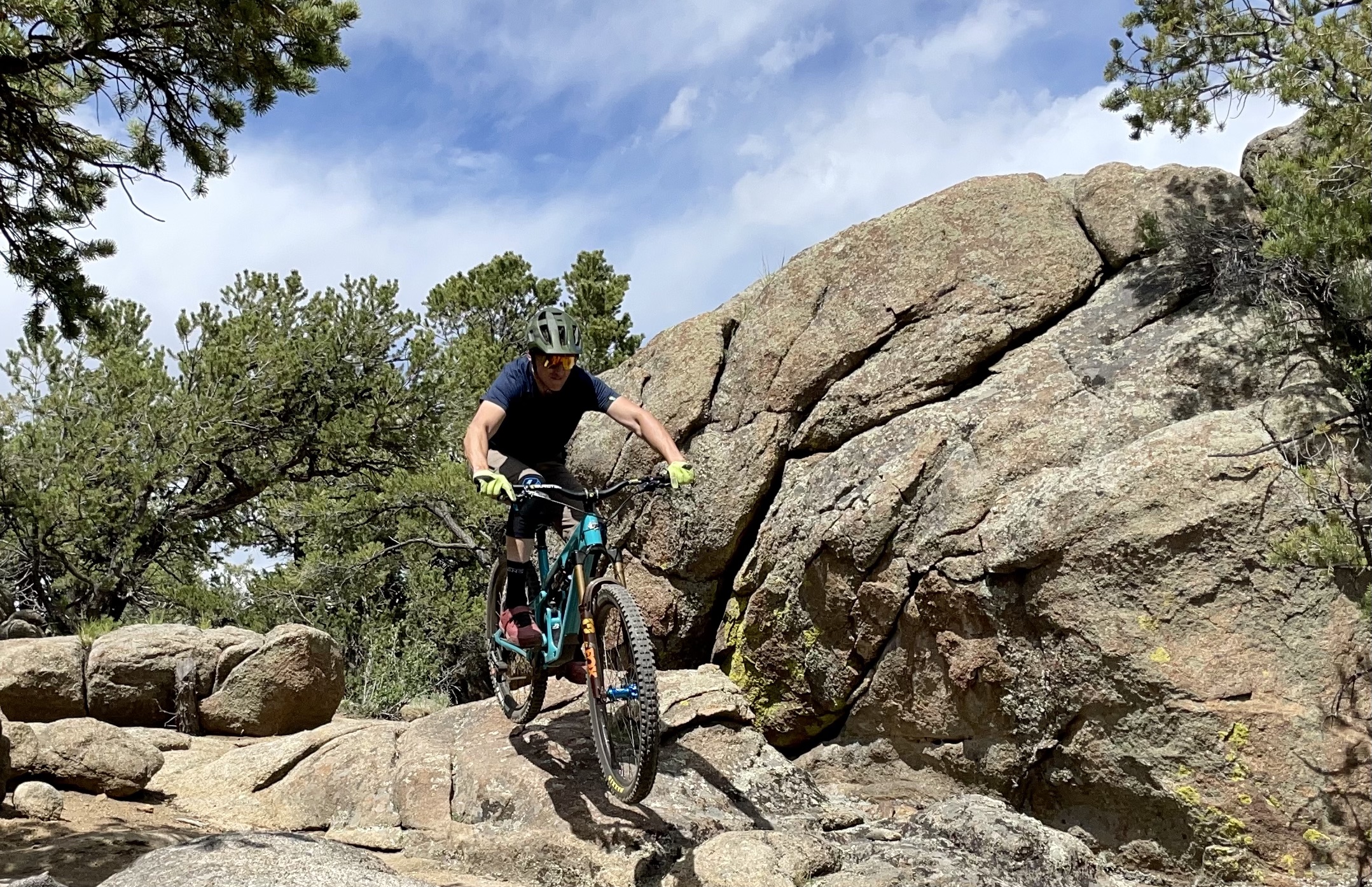
I think this is due in part to the 135 mm of rear travel coming across as more than it is on paper, and much of that comes from the SB135’s strong bottom-out resistance, thanks to an increase in progression right at the end of the travel. This isn’t to say I didn’t bottom out the SB135 — I most definitely did — but it seemed like those bottom-outs were more in line with what I would expect from a bike that has 150 mm of rear travel.
The SB135 does some of its best work on more sculpted downhill flow-type trails. My favorite descents on the SB135 have been at the Crested Butte Mountain Bike Park, which has a mixture of those aforementioned trails and more natural, raw ones. There, the SB135’s fun side really shines through and I thoroughly enjoy its quick handling and playful nature. According to Yeti, its low bottom bracket improves cornering, though, at 337 mm, it’s not that crazy low. I find it difficult to discern cornering differences based on a few millimeters less of bottom bracket height anyway but will say that, in conjunction with the bike’s 27.5’’ wheels, supportive suspension, and centered riding position, the SB135 is one of the best bikes that I‘ve been on in recent memory when it comes to railing berms.
Many of my local trails are far from sculpted and more on the rocky, natural side — some might even say they can be a no-flow zone. Those sorts of trails present more of a challenge for the SB135. On those trails, I find its quick handling to be an asset, but 27.5” wheels simply just don’t maintain the same momentum as 29” wheels, which in turn makes it harder to take full advantage of the SB135’s quickness and playfulness.
David: Bikes in this travel range (thinking more of those with ~135 mm in the rear than 160 mm in front) can land on a pretty wide spectrum: from feeling like XC-derived bikes with some extra travel and slightly longer / slacker geometry, to mini-Enduro sleds that have just been made a little more compact and quicker handling. The SB135 is much more of the latter, but with the playfulness slider pushed way up, rather than feeling like a super focused go-fast race bike. Its fit and handling are much more akin to a bigger, longer-travel bike, at least from the standpoint of body positioning and steering feel, but it’s much, much quicker handling and more responsive than any modern Enduro bike I can think of.
In the right terrain, that’s an extremely fun combination. The SB135 is super quick and agile in its handling while still managing to feel reasonably stable if it’s ridden with some precision. It’s not a bike that just wants to bulldoze whatever’s in front of it, and in steeper, rougher terrain, it does take more steering input to keep tracking than a lot of similarly situated 29ers. In trade, the SB135 corners very, very well, and is a ton of fun to throw around in the air, slash around, and otherwise ride with a more playful approach.
I also think those traits will appeal to a segment of riders who just want a bike that’s got a good bit of suspension and intend to ride terrain that’ll put it to use (like Simon, I’d have guessed that the SB135 had a bit more rear travel than it actually does), but who find a lot of modern 29ers to be too sluggish and slow to respond to input — even if they’re rarely going to get off the ground. A lot of folks have probably forgotten what a bike with two 27.5’’ wheels feels like at this point — or haven’t ever ridden a truly modern one — and the SB135 is a great reminder of what you lose in agility when going to 29’’ wheels.
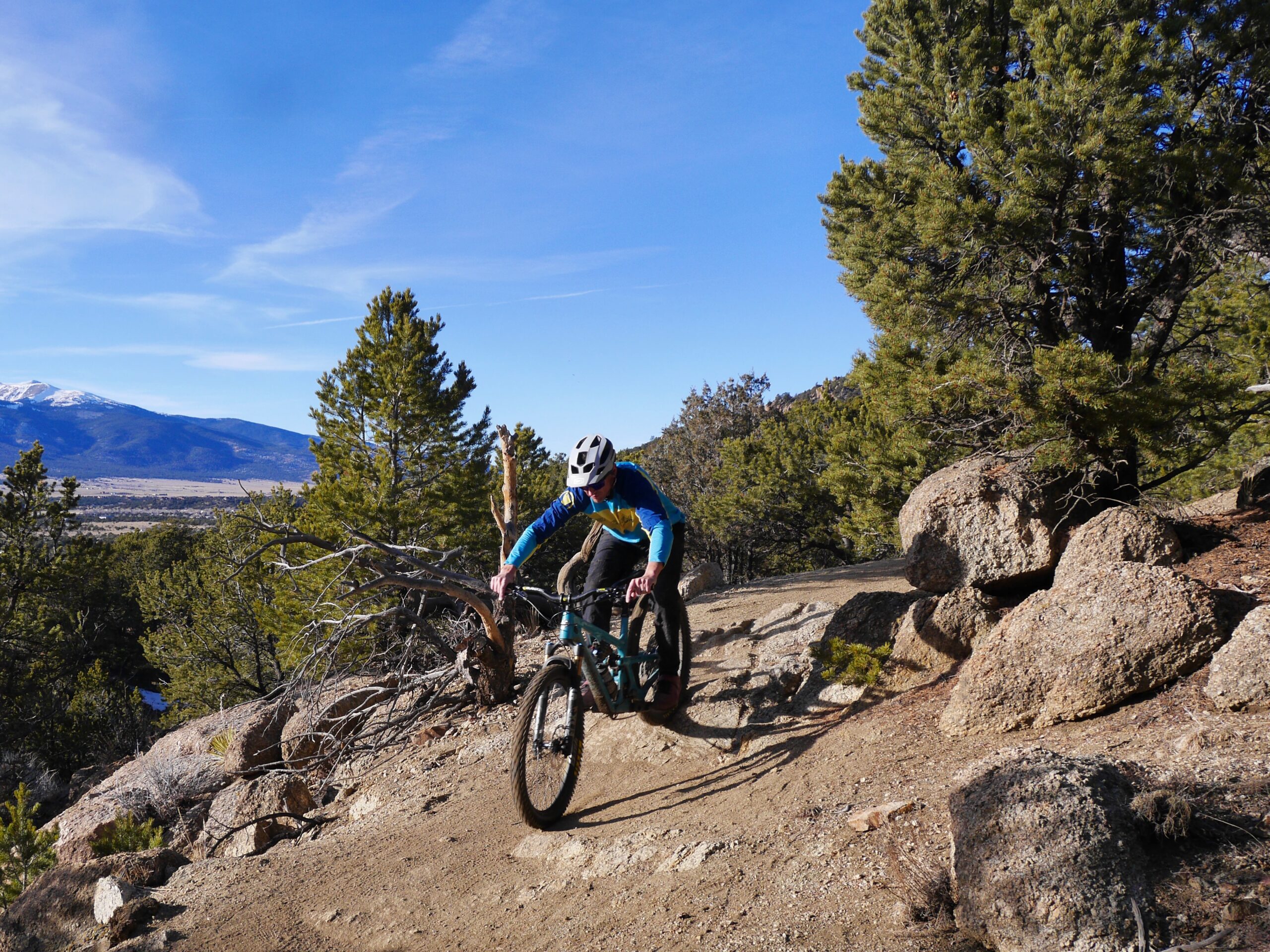
I also had a good time on the SB135 on some pretty rough trails that had a bit of pitch to them, where maintaining momentum wasn’t as much of a challenge, thanks to gravity taking over. Simon rode far, far more anti-flow chunk on the SB135 than I did, so I’ll defer to his take on that stuff. But I mostly want to dispel the idea that little wheels don’t work or aren’t fun on rougher trails. Compared to a lot of otherwise similar 29ers, the SB135 feels like it takes a bit more steering input to keep tracking when things get steep and rough, but I’d view that almost more as just a change in required approach than a loss of capability.
Descending: SB135 Mullet
Simon: Unlike the climbing performance, where I called out a tie, the edge here goes to the SB135 in the stock 27.5’’ configuration. Descending chunky terrain on the mullet-converted SB135 exposed a weakness in the way of fork travel — I mentioned above how the SB135 Lunch Ride’s rear travel feels like more than it is and is well balanced with its 160mm-travel fork.
When swapped over to the mullet, the 140mm-travel fork felt undergunned, resulting in an unbalanced feel. The SB135’s personality encourages an aggressive riding style that tends to overwhelm the shorter-travel fork that is necessary when doing a mullet swap. I did briefly consider changing out the air spring in the Fox 36 Factory to a 150 mm one, but with the geometry already altered on the slacker side with the 140mm-travel 29” fork, it was a tradeoff I wasn’t willing to make.
The Build
Simon: We’ve been testing the SB135 with its TLR T3 build, and it’s well thought out. We did swap out the handlebars as mentioned in the “Fit” section, but I put handlebars in the same category as saddles, grips, and stems — matters of personal preference that you can’t get right for everyone no matter what — so I’m not docking the build as a result.
[David: I agree with Simon in principle, but I still think the cockpit adjustment range on the SB135 would be a lot more useable overall if the headtube (and therefore the stack height) was taller on the bigger sizes.]
Simon: Our test bike came with DT Swiss EX1700 wheels, which have been flawless and remained perfectly true. However, after a look at Yeti’s website, it appears that they replaced them with Raceface ARC Offset 30 mm rims, paired with DT Swiss 350 hubs. I haven’t spent much time on the RaceFace ARC rims, but I have a ton of time on the DT Swiss EX1700 wheels, as well as wheels running DT Swiss EX511 rims with DT Swiss 350 hubs (which is basically the same as the EX1700 wheelset), and they are on my list of favorite Enduro-level wheels.
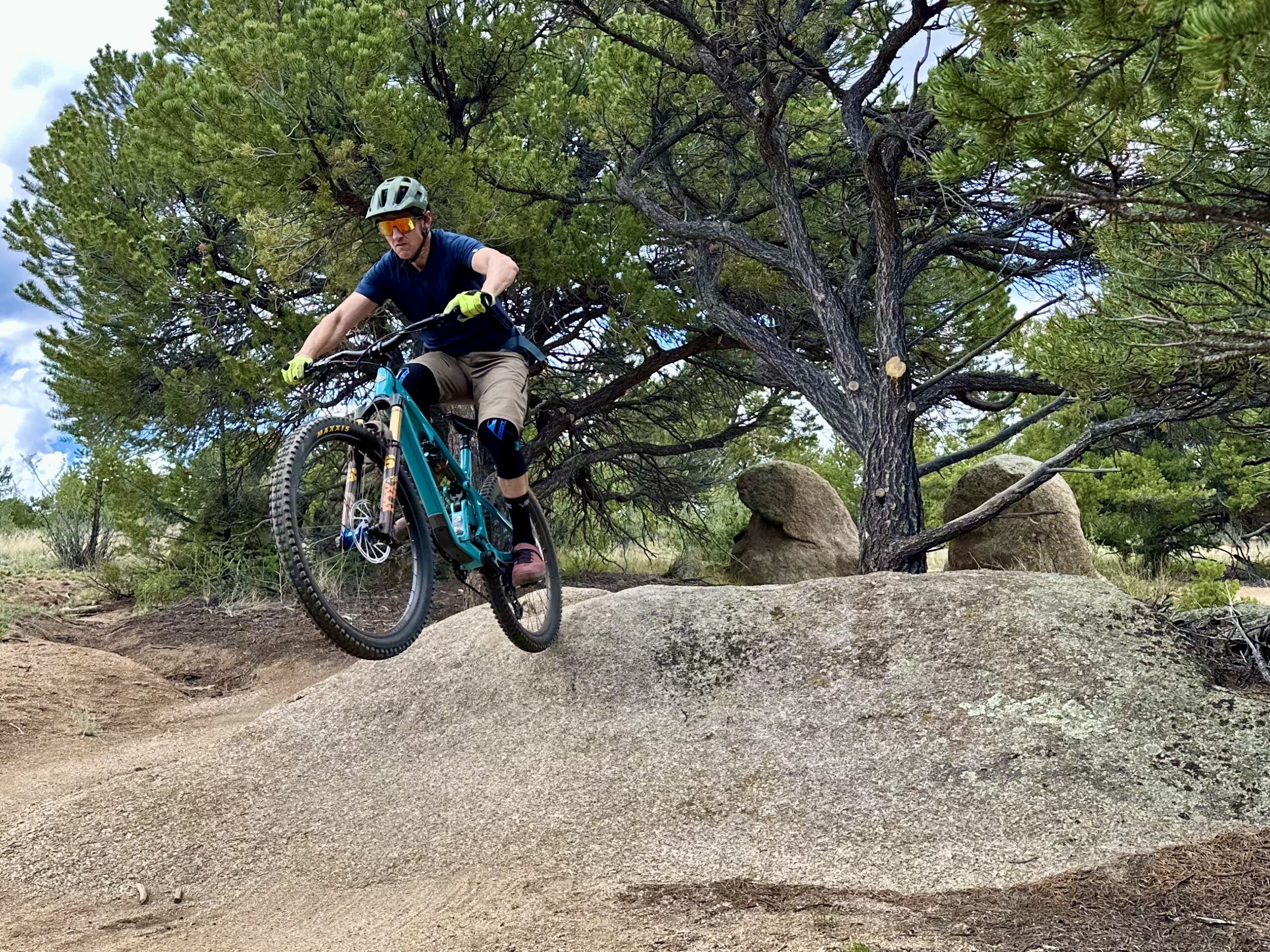
One of the TLR T3 build’s highlights is the SRAM X0 Transmission. I know it has been out for a while now, but I still get excited when I pull a test bike out of the box and the first thing I see is an AXS shifter pod. That said, in comparison to the first-generation AXS Eagle drivetrain, I definitely seem to smack the derailleur more on the AXS Transmission and can hear its override clutch working more often — this has not been an issue, just an observation. Overall, the AXS Transmission on the SB135 hasn’t missed a beat in terms of performance (see this episode of Bikes & Big Ideas for more Transmission thoughts). Other build highlights include the Fox Factory suspension and the SRAM Code brakes with 200 mm rotors front and rear.
The build seems almost ideal, and it loses a potential perfect score in my book only because its Fox Transfer post has been sticky. This Transfer has been performing like a lot of Transfer posts I’ve been on lately, which is poorly. To be clear, it is mostly ok until the temperature drops to near freezing, but then it sticks so badly that I have to manually pull it back up just about every time.
On the durability side, I’m thankful that Yeti opted for a threaded bottom bracket design — I doubt there are many people out there who still prefer a press-fit bottom bracket. The SB135’s Switch Infinity system hasn’t required any additional service apart from keeping it clean and greasing it through the grease ports at the recommended 40-hour intervals. That does require some linkage disassembly to get the swingarm out of the way of the rear Switch Infinity grease port, which is a minor hassle. The procedure hasn’t changed from my SB140, and while it bothered me initially since the whole idea behind having grease ports in the first place is to make servicing easier, once you’ve done it a few times, it’s really not a big deal.
Colorado’s dry climate is usually pretty nice to bearings as a whole, and the Switch Infinity slider assembly has not been problematic. That said, I do recommend inspecting the carrier bearings on the slider assembly during the slider service — the bearings have a tough job since they have a very small range of rotation, which makes them extremely susceptible to corrosion, pitting, and often seizing.
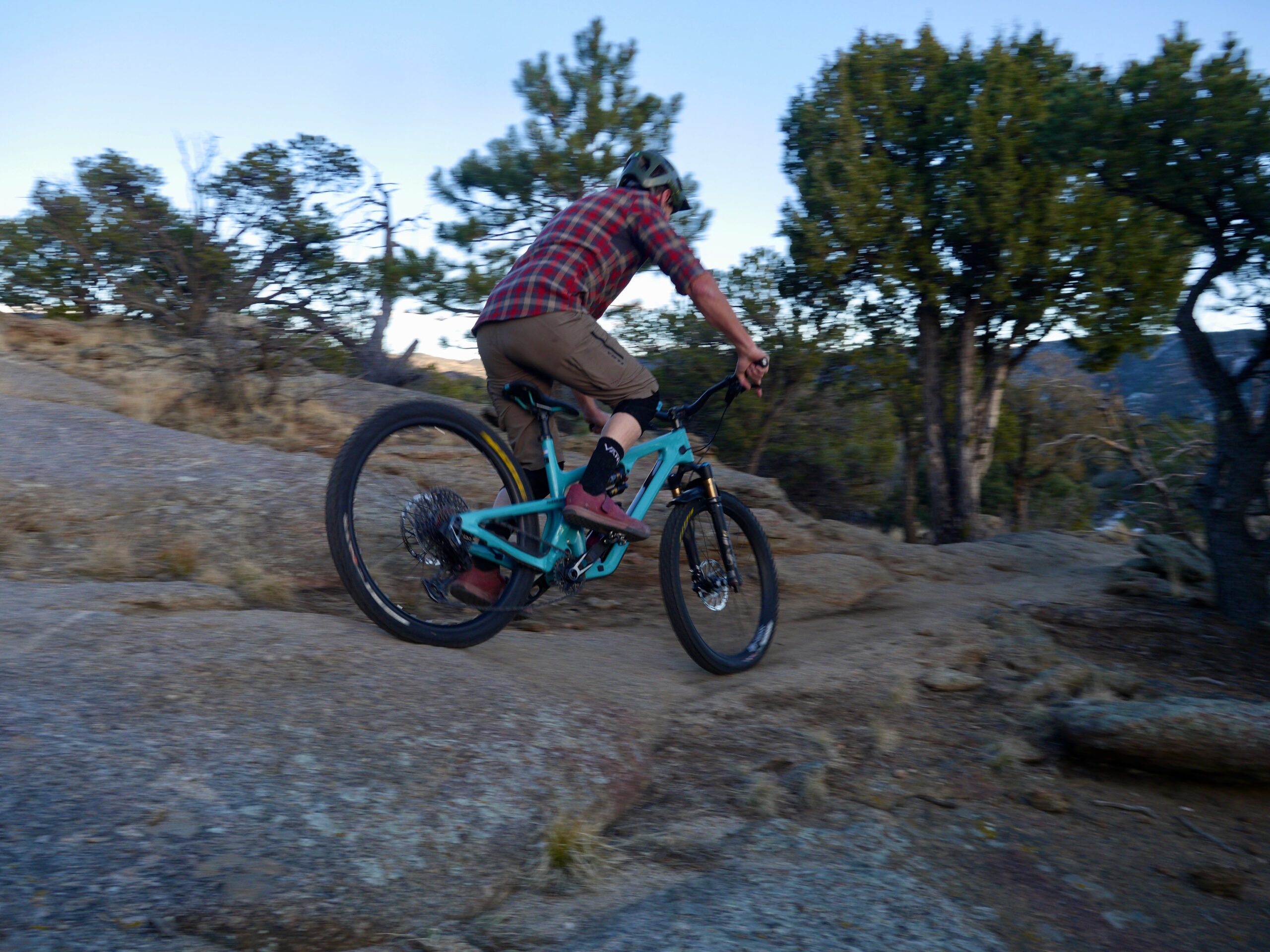
One other note on bearings, from someone who has replaced countless bearings pressed into carbon frames, is that Yeti’s decision to locate the bearings in the metal linkages instead of in the frame is a welcome change. Thankfully, I’ve never had a catastrophic incident while replacing bearings that were pressed into carbon, but the possibility is always is in the back of my mind, and if things were to go sideways, it would be an expensive mistake.
David: Not much to add here. I think Yeti has done a sensible job of offering both lighter build specs on the standard SB135 and a thoughtfully beefed-up version on the “Lunch Ride” version. Like Simon, I’d prefer the DT Swiss EX1700 wheels that we got on our bike over the Race Face ARC rims that come on the more recent builds (my experience is that the latter are generally fine, but a bit less bombproof than the EX1700).
I’d be curious to see Yeti’s split of standard vs. LR builds sold on the SB135 because my hunch is that the latter option is going to appeal to more folks who are drawn to the SB135 in the first place. The most obvious exception would be some shorter riders who are just stoked about the SB135’s truly small sizing options — which, again, kudos to Yeti for taking seriously.
But to me, the SB135 feels most in its element as something of a mini freeride bike, looking for stuff to jump off, berms to smash, and generally riding somewhat aggressively — just not necessarily with an eye on the clock. Those sorts of folks are going to appreciate the bigger brakes and beefier wheels on the LR builds, the Grip2 damper in the fork, and so on. The lighter build specs totally make sense on some of Yeti’s snappier, more focused offerings, but the SB135 seems like the sort of bike that’s really begging for the LR option.
Who’s It For?
Simon: A lot of riders probably view the Yeti SB135 as a niche bike, which has more to do with the stigma of 27.5’’ wheels being outdated than anything else. That’s a shame because, based solely on how it rides, the SB135 will appeal to a lot of folks who favor playing with the trail rather than trying to trim seconds off a run.
It wasn’t too long ago that 27.5’’ bikes were a popular choice, and there were good bikes back then, too. For riders whose 27.5’’ bikes are at the end of their life cycle and/or who prefer a 27.5’’ bike over a 29er, the SB135 presents a great option. Additionally, riders who live in areas with sculpted berms and a lot of flow and jump trails should take a close look at the SB135.
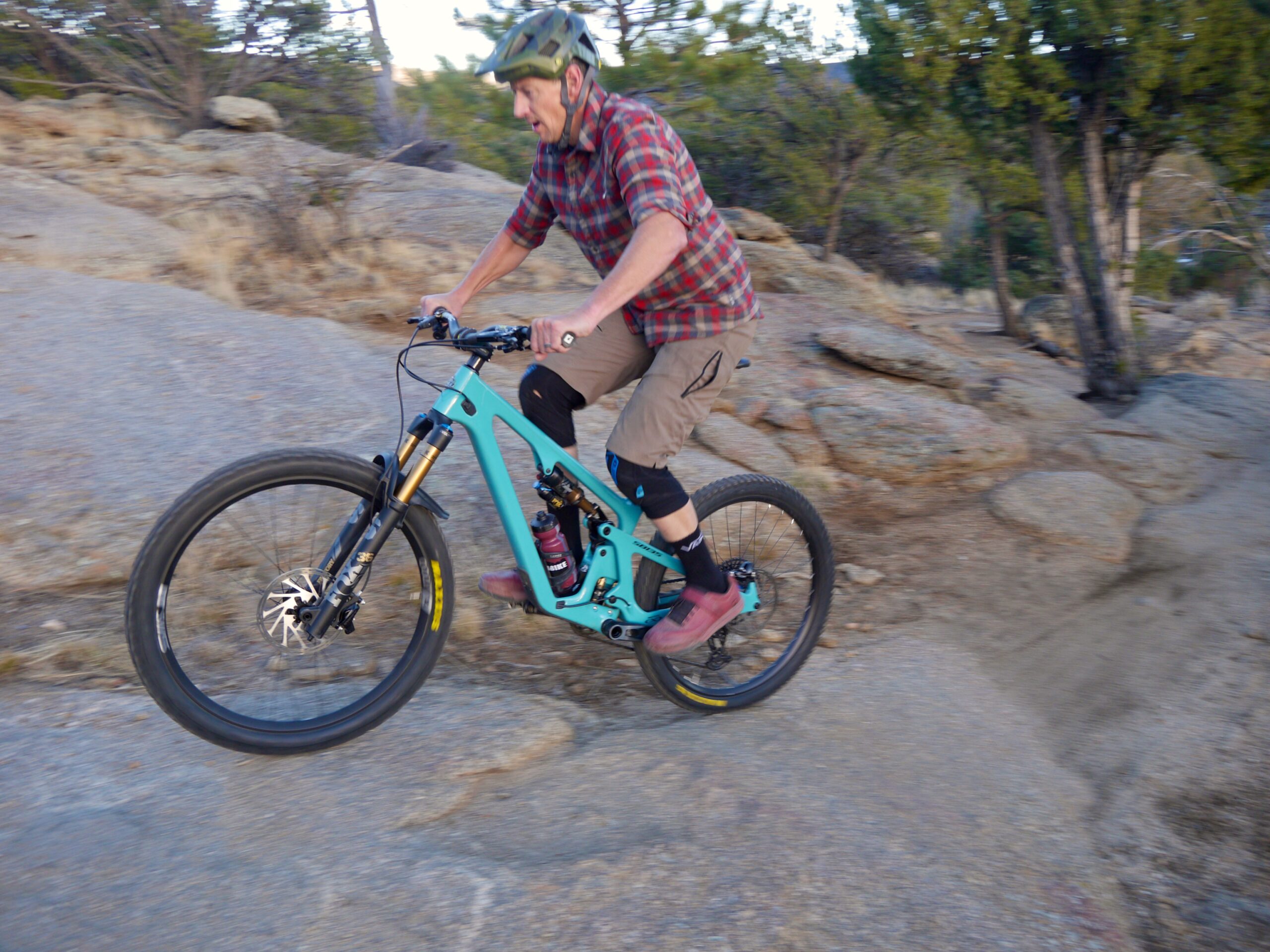
Then there’s the compelling case for small-sized riders that can’t be ignored — the SB135’s size-specific frame makes a big difference in standover height as well as having shorter chainstays. My 5’1’’ wife absolutely loves the SB135 for these reasons, and if there’s one demographic who should have the SB135 on their radar, it’s those who ride XS and Small-sized bikes. Plus, the size XS SB135 even fits a water bottle.
Regarding the SB135 Mullet: I think the SB135 as a mullet will resonate with riders who enjoy working on their own bikes and like to ride something that is unique, somewhat custom, and a bit trendy. I like the SB135 as a mullet, but bear in mind it’s not a free lunch, and in my opinion, bikes designed from the factory with mixed-wheel sizes are usually a better option.
David: I keep coming back to the descriptor of “mini freeride bike” for the SB135, and I think it fits — again, especially for the LR build that we tested. The SB135 delivers a super fun combination of being very nimble and easy to throw around while having enough suspension and stability to do much more than just comfortably ride smooth flow trails. It takes a bit more precision to ride quickly in steeper, rougher terrain than a lot of other ~140mm-travel Trail bikes, but can absolutely do it under the right rider — while still being super quick-handling, playful, and a lot of fun in the air.
Bottom Line
Simon: The SB135 absolutely delivers on Yeti’s promise of a fun, flick-able bike that rewards creative line choices. It’s a bike that I like climbing and descending on. Its quick handling, which took more than a few rides to calibrate to, is a fun counter to the trend of long, slack, and stable Enduro bikes. Flowy, berm-laden trails with jump lines really play to the SB135’s strengths, and on these trails, it is superb. Unfortunately, the majority of my local rocky trails don’t do the SB135 any favors, leaving its 27.5’’ wheels often feeling like they are fighting the trail to maintain momentum, while its low bottom bracket can make pedaling through rock gardens a tricky endeavor. As a mullet, the SB135 feels more current and generally more agreeable on some of my chunky undulating local trails, but it also isn’t as nicely balanced and does not descend as well.
Overall, I like both configurations and there is no clear winner between the two, nor does there need be, since they will appeal to different riders. Here’s the rub though: if Yeti also made a version of the SB135 as a mixed-wheel size bike with unchanged geometry and a longer-travel fork, I have no doubt that one would be my choice.
As it stands now, the SB135 and I have a complicated relationship — I had amazing rides where I was fully in love with it, but also had rides where we couldn’t get along and finished mad at each other.
I began this review by saying that my SB140 27.5 mullet is one of my all-time favorite bikes, but as much as I love it, I would love it more with a longer-travel fork. The SB135 is a better bike than my SB140 in every regard, but I want to have my cake and eat too — and for the terrain that I find myself on most often, that would mean a factory-built SB135 mullet.
David: I think I feel less conflicted about the SB135 than Simon does. If you want an all-rounder Trail bike that’s notably quick handling, easy and fun to throw around, and doesn’t take a lot of speed or pitch to come alive, but still has the suspension performance and enough stability to handle some steeper, rougher trails too, I haven’t ridden anything with quite the same blend of traits as the SB135. It does feel different from the sea of 29’’ wheeled bikes in its travel range, and it does take a little bit of a different riding approach for it, but that’s a difference to be celebrated. There are many, many good mountain bikes out there these days (and increasingly few objectively bad ones) and I applaud Yeti for making something a bit unorthodox, but really damn fun.
Deep Dive Comparisons
BLISTER+ members and those who purchase our Digital Access Pass can check out our Deep Dive comparisons linked below. Get our Digital Access Pass to view all our Deep Dives and Flash Reviews, or become a BLISTER+ member today to get access to that and a LOT more, including the best worldwide Outdoor Injury Insurance, exclusive deals and discounts on skis, personalized gear recommendations from us, and much more.
Check out our Deep Dive comparisons of the Yeti SB135 to see how it compares to the Yeti SB140 27.5’’, Esker Rowl, Ibis Ripmo V2S, Pivot Shadowcat, Transition Scout, Yeti SB140 29’’, Trek Fuel EX, Transition Smuggler, and SCOR 2030.

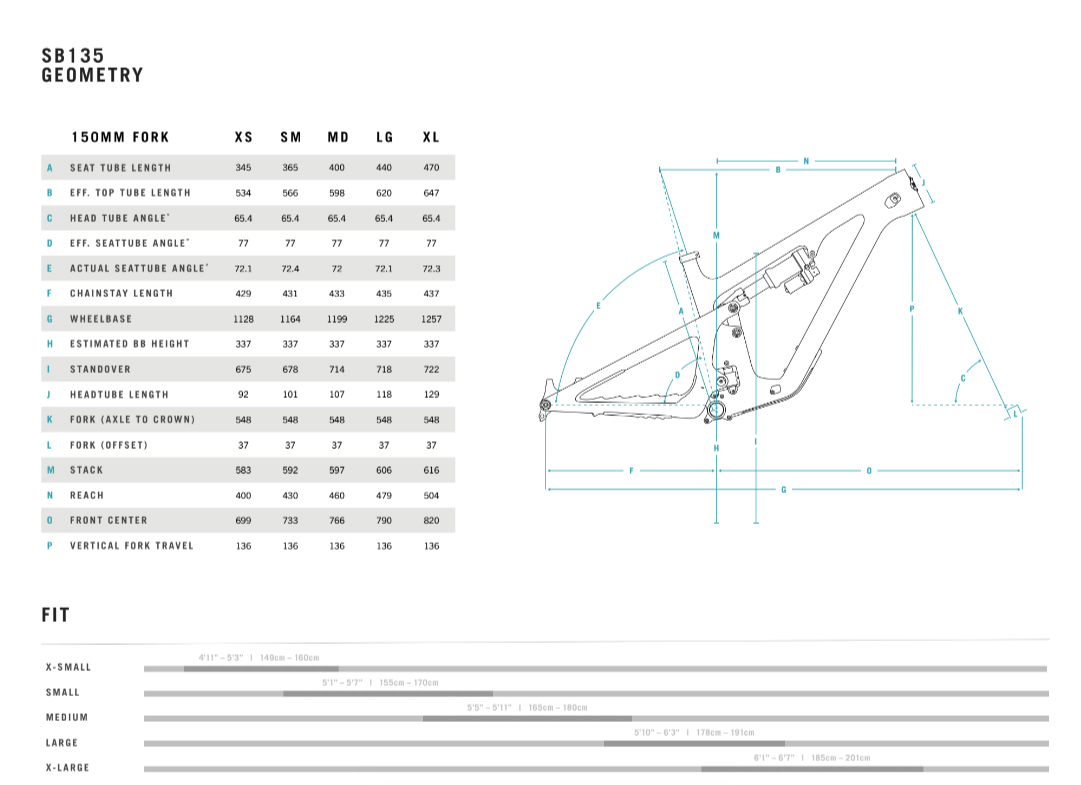
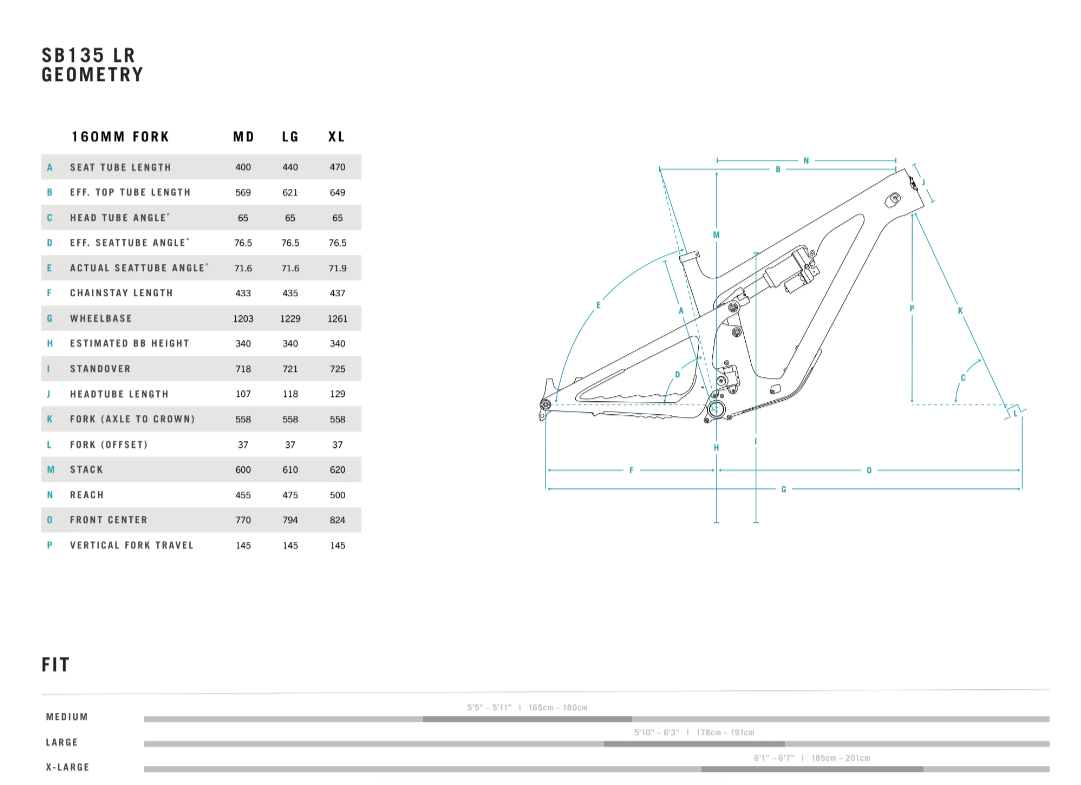
We built up my wife’s SB135 with a 29er Lyric 150mm, and so far loving it. The 150 with 29 wheel was almost the same front end height as the 160mm 27.5.
Can I point out the Orange Alpine Evo, which is a full 27.5″ 160/155mm trail bike. I own one and while it has a very different suspension layout to the Yeti it is so much fun to ride. 63° head angle, 495mm reach (L) and a 1280mm wheelbase. It absolutely flies downhill but retains the agility you’d expect from the smaller wheels. I’ve never felt any need to switch to a full 29er or even a mullet.